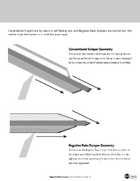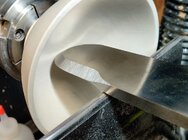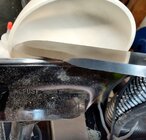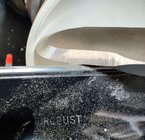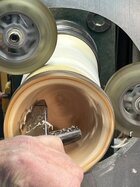Having started this thread I suppose I should put my cards on the table. I seem to have acquired a largeish number of scrapers, most of them gifted and repurposed, mostly negative rake scrapers.
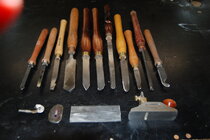
The small scrapers on the left are single-purpose tools for shaping square and dovetail tenons, the next is a standard box scraper, and the fourth I sometimes use for shear scraping convex forms - all have a flat top surface. The rest have a negative rake, mostly 21* on top and 62* below, keeping the included angle under 90* and odd angles because that is what I get with my RoboRest setup. I have tried removing and re-raising a burr on these tools but have reverted to using the burr off the grinder. The Drozda box scraper and the gooseneck tool on the right have an included angle of about 45*. The three tools at center are 1/2" thick, reassuring when reaching off the toolrest (but the previous owner of the long skinny tool bent it inside a hollow form!). The teardrop on a Jamieson mount at bottom left is used on every hollow form- I have used it only flat, but I will try rotating it for shear scraping as Neil S described above.
I'm not sure how important the top angle is. I suspect that a smaller included angle dulls more quickly and that an obtuse angle would make producing a good burr difficult. I eagerly await the forthcoming scientific study on scraper steel and angles.
The StewMac hand scraper is invaluable for spot cleanup and smoothing out carved surfaces, thick enough to give it some authority and with a variety of curvature. It's used with the grinder burr. The card scraper is rarely used for turning but handy occasionally for getting at sharp inside corners. I usually polish off the grinder burr and raise a fine burr with a carbide rod on this one, but sometimes just use the filed edge. The last two are used strictly with the piece stationary. The little cabinet scraper is for flatwork and I include it just to show a very effective negative rake scraper with no burr at about a 5-10* variable angle.
When I shear scrape it is always on convex surfaces and usually with a swept-back bowl gouge. I will have to try shear scraping on interiors. I reach for the negative rake scrapers more often and I frequently spray a bit of water on the surface to soften the fibers. I seem to get different results with the same tool and approach on different types of wood as Robo Hippy suggests, so I distrust categorical statements like "Shear scraping yields a better surface both on the inside and outside of a bowl."
I have to disagree with the idea held by some that negative rake scrapers are the equivalent of a standard scraper held at a downward angle. That may be true in a specific case but when a scraper is held at an angle other than flat the effective angle of the edge to the wood changes with the distance off the tool rest. An NRS allows for holding the tool level with a constant negative attack angle relative to the work.
Thanks for all the responses. I always learn something from a thread like this, both about tools and about people's approaches to turning (and posting).

The small scrapers on the left are single-purpose tools for shaping square and dovetail tenons, the next is a standard box scraper, and the fourth I sometimes use for shear scraping convex forms - all have a flat top surface. The rest have a negative rake, mostly 21* on top and 62* below, keeping the included angle under 90* and odd angles because that is what I get with my RoboRest setup. I have tried removing and re-raising a burr on these tools but have reverted to using the burr off the grinder. The Drozda box scraper and the gooseneck tool on the right have an included angle of about 45*. The three tools at center are 1/2" thick, reassuring when reaching off the toolrest (but the previous owner of the long skinny tool bent it inside a hollow form!). The teardrop on a Jamieson mount at bottom left is used on every hollow form- I have used it only flat, but I will try rotating it for shear scraping as Neil S described above.
I'm not sure how important the top angle is. I suspect that a smaller included angle dulls more quickly and that an obtuse angle would make producing a good burr difficult. I eagerly await the forthcoming scientific study on scraper steel and angles.
The StewMac hand scraper is invaluable for spot cleanup and smoothing out carved surfaces, thick enough to give it some authority and with a variety of curvature. It's used with the grinder burr. The card scraper is rarely used for turning but handy occasionally for getting at sharp inside corners. I usually polish off the grinder burr and raise a fine burr with a carbide rod on this one, but sometimes just use the filed edge. The last two are used strictly with the piece stationary. The little cabinet scraper is for flatwork and I include it just to show a very effective negative rake scraper with no burr at about a 5-10* variable angle.
When I shear scrape it is always on convex surfaces and usually with a swept-back bowl gouge. I will have to try shear scraping on interiors. I reach for the negative rake scrapers more often and I frequently spray a bit of water on the surface to soften the fibers. I seem to get different results with the same tool and approach on different types of wood as Robo Hippy suggests, so I distrust categorical statements like "Shear scraping yields a better surface both on the inside and outside of a bowl."
I have to disagree with the idea held by some that negative rake scrapers are the equivalent of a standard scraper held at a downward angle. That may be true in a specific case but when a scraper is held at an angle other than flat the effective angle of the edge to the wood changes with the distance off the tool rest. An NRS allows for holding the tool level with a constant negative attack angle relative to the work.
Thanks for all the responses. I always learn something from a thread like this, both about tools and about people's approaches to turning (and posting).
Last edited:

